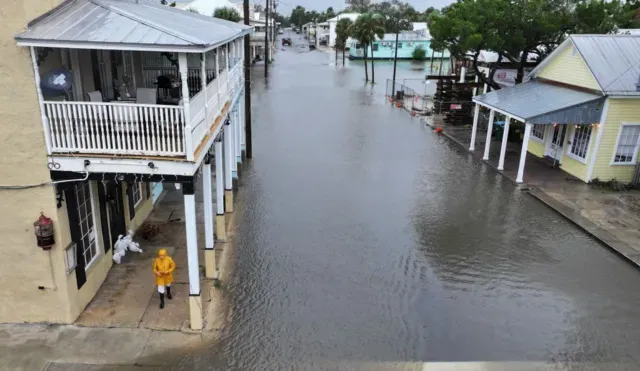Introduction
Tropical Storm Debby has brought significant devastation to the southeastern United States, leaving a trail of destruction and causing multiple fatalities. Originating as a Category 1 hurricane, Debby made landfall in Florida’s Big Bend region before weakening into a tropical storm. This detailed account examines the storm’s impact, the response from authorities, and the broader implications of such extreme weather events.
The Path of Destruction
Debby’s Landfall and Early Impact
Tropical Storm Debby made its initial landfall on Monday morning, striking the Big Bend region of Florida’s Gulf Coast. This area, known for its vulnerable coastal communities, experienced the full force of the storm’s winds and rain. As Debby moved inland, it transitioned from a hurricane to a tropical storm but continued to pose a significant threat due to its slow-moving nature and heavy rainfall.
The storm’s impact was immediately felt across the region, with extensive flooding and damage reported in several counties. Debby’s slow progression over the land contributed to prolonged periods of heavy rain, exacerbating flooding conditions and increasing the risk of structural damage.
Fatalities and Property Damage
Florida’s Struggle with Debby
The storm’s ferocity has led to at least five confirmed fatalities. Among the victims was a 13-year-old boy who tragically lost his life when a tree fell onto a mobile home in Levy County, located near Gainesville. This incident highlights the severe risk that falling trees and other debris posed during the storm, particularly to those in vulnerable housing situations.
In Hillsborough County, near Tampa, an 18-wheel lorry was swept off the road and into a canal by the storm’s intense winds. The driver was found deceased, underscoring the dangers faced by individuals traveling during extreme weather conditions.
In Dixie County, just west of Gainesville, a woman and a 12-year-old were killed when their car crashed amid the storm’s severe conditions. This tragic event illustrates the hazardous driving conditions and the broader impact of Debby on transportation infrastructure.
Another reported fatality occurred in southern Georgia, where a 19-year-old was killed when a large tree fell onto a porch in Moultrie. The extensive damage caused by falling trees and debris was a recurring theme throughout the storm’s impact.
Power Outages and Infrastructure Damage
The storm caused widespread power outages across the affected regions. As of Monday night, approximately 150,000 homes and businesses in Florida were without power. Additionally, around 36,000 residents in Georgia and South Carolina experienced similar outages. The widespread loss of electricity exacerbates the challenges faced by residents and emergency services, complicating rescue and recovery efforts.
The impact on infrastructure was also significant, with reports of damage to roads, buildings, and utilities. In Florida, the situation was compounded by the recent history of hurricane-related damage, as many residents were still recovering from Hurricane Idalia, a Category 3 storm that made landfall the previous summer.
Environmental and Economic Impact
Environmental Effects
Debby’s strong winds and waves had unintended consequences, including the deposition of contraband along the Florida Keys. According to the US Border Patrol, the storm’s waves and winds carried 25 packages of cocaine, valued at over $1 million, ashore. This incident highlights the broader environmental effects of the storm, which included the displacement of both natural and man-made objects.
Economic Implications
The economic impact of Tropical Storm Debby is significant, with extensive damage to homes, businesses, and infrastructure. The costs associated with repairs and recovery are expected to be substantial, adding financial strain to communities already affected by previous storms. The power outages and property damage will require substantial investment in repairs and restoration, further impacting the local economy.
Forecast and Future Implications
The Storm’s Path and Expected Impact
As Tropical Storm Debby continues its path, it is forecasted to bring heavy rainfall and potential flooding to southeast Georgia and the Carolinas. The National Hurricane Center has issued warnings of “life-threatening” flood threats due to the storm’s slow movement, which could result in “catastrophic flooding” in affected areas. The storm is expected to skim the coast before moving inland near the South Carolina coast later in the week.
Authorities have been actively involved in monitoring the storm’s progress and issuing alerts to keep the public informed of potential dangers. The focus is on ensuring the safety of residents and coordinating emergency response efforts to address the immediate needs of those affected.
Broader Trends and Climate Change
The 2024 hurricane season, which runs from June 1 to November 30, has been predicted to be particularly active, with up to 25 named storms expected. Between eight and thirteen of these storms could develop into hurricanes. Debby is the fourth named storm of the year, highlighting the ongoing activity in the hurricane season.
The potential influence of climate change on storm behavior is a growing concern. There is evidence suggesting that climate change may contribute to an increase in the frequency and intensity of slow-moving hurricanes. As global temperatures rise unevenly, changes in atmospheric circulation patterns can affect the movement and behavior of storms, leading to more extreme weather events.
For more in-depth articles and analyses on weather events and their impacts, visit our US & Canada section here.


